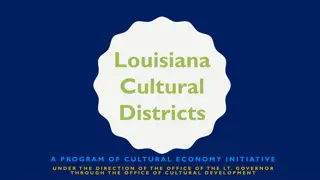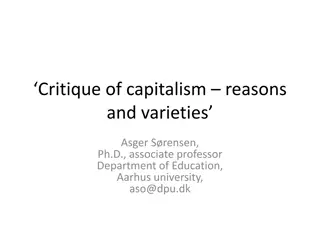Critique of Unilinear Cultural Evolution Models
The drawbacks of unilinear cultural evolution models are explored, focusing on the assumption that all cultures follow a single linear path of development. Issues such as the emphasis on material culture, overlooking of other cultural aspects, and the ethnocentric perspective towards Western culture are discussed, challenging the notion of cultural progression as a linear evolution.
Download Presentation

Please find below an Image/Link to download the presentation.
The content on the website is provided AS IS for your information and personal use only. It may not be sold, licensed, or shared on other websites without obtaining consent from the author.If you encounter any issues during the download, it is possible that the publisher has removed the file from their server.
You are allowed to download the files provided on this website for personal or commercial use, subject to the condition that they are used lawfully. All files are the property of their respective owners.
The content on the website is provided AS IS for your information and personal use only. It may not be sold, licensed, or shared on other websites without obtaining consent from the author.
E N D
Presentation Transcript
The drawbacks of Unilinear Cultural Evolution models Howard Culbertson Southern Nazarene University Cultural Anthropology
Cultural evolution models Assume that all cultures developed along one unilinear path Line up all cultures on a single development or success scale See cultures progressing upward toward perfection
The picture in our minds Civilized Primitive
L.H. Morgan, 1818-1881 Student of American Indian cultures A founder of anthropology as scientific field of study
Morgan: a child of his time Morgan was contemporary of biologist Charles Darwin (1809-1882)
L.H. Morgans Stages Morgan saw all cultures evolving through three stages Savagery Barbarism Civilization
Cultural evolution models Every element of culture moves from simple to complex From primitive (tribal) to civilized (modern Western)
Pyramid of human development Higher civilization Civilization Lower civilization Higher barbarism Barbarism Lower barbarism Higher savagery Savagery Lower savagery
Drawback Number One Cultural evolution thought focuses on material cultural products Example: Morgan traced evolution of dwellings
Questions for reflection Is culture only -- or even essentially -- technology and material products? What about worldviews? What about language?
Drawback Number Two Modern Western culture is held up as the pinnacle of cultural development Analysis made from etic viewpoint
Ethnocentric issues They are not very good at what we are best at By evaluating them on what we are best at, we miss what they handle more competently than we
Drawback Number Three Cultural evolution models lump together all societies displaying certain characteristics
Drawback Number Four Cultural Evolution often posits a progressive rise in human rationality Some cultures get labeled as child- like and others as mature in their thinking Assumes primitive / developed languages
Question for reflection Paul Hiebert: Are modern people really all that logical? Did (or do) tribals think in simplistic, prelogical terms?
This PowerPoint presentation is available along with related materials and other PowerPoint presentations at http://home.snu.edu/~hculbert/ppt.htm























